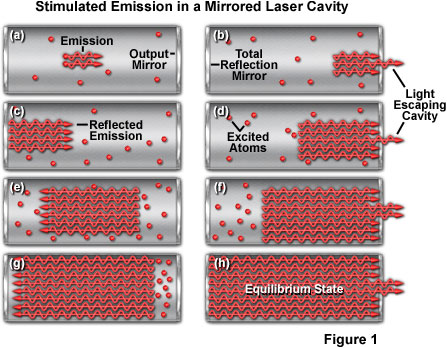Stimulated Emission in a Laser Cavity
Stimulated Emission in a Laser Cavity - Java Tutorial
The amplification of light by stimulated emission is a fundamental concept in the basic understanding of laser action. This interactive tutorial explores how laser amplification occurs starting from spontaneous emission of the first photon to saturation of the laser cavity and the establishment of a dynamic equilibrium state.
The tutorial initializes with multiple excited atoms (red spheres) randomly colliding with each other and the inner walls of a laser cavity. Several light waves spontaneously appear to simulate the process of stimulated emission from an external energy source (not illustrated). The waves propagate back and forth through the laser cavity, with the intensity increasing at each pass (more waves are formed), but some of the light is passed through the partially reflecting mirror (output mirror) on the right side of the laser cavity. Eventually the laser reaches an equilibrium state where the cavity is filled with oscillating waves and pumping a continuous flow of light through the mirror. The amount of time required for this transition can be adjusted with the Applet Speed slider.
In addition to the creation of a population inversion, several other factors are required to amplify and concentrate light into a laser beam. Light from stimulated emission produced in a laser medium usually has a single wavelength, but must be extracted efficiently from the medium by some mechanism that includes amplification. This task is accomplished in a resonant cavity, which reflects some of the emission back into the laser medium and, through multiple interactions, builds or amplifies the light intensity. For example, after the initial stimulated emission, two photons having the same energy and phase are each likely to encounter excited atoms, which will subsequently emit even more photons having the same energy and phase. The number of photons produced by stimulated emission grows rapidly, and the increase is directly proportional to the distance the light travels in the laser medium.
Presented in Figure 1 is an illustration of the gain, or amplification, that occurs with increased path length in the resonant cavity due to the mirrors at each end. Figure 1(a) shows the beginning of stimulated emission, which is amplified in Figure 1(b) through Figure 1(g) as the light is reflected from the mirrors positioned at the cavity ends. A portion of light passes through the partially reflected mirror on the right-hand side of the cavity (Figures 1(b,d, and f)) during each pass. Finally, at the equilibrium state (Figure 1(h)), the cavity is saturated with stimulated emission.
The degree of amplification achieved in a laser, expressed by the term gain, refers to the amount of stimulated emission a photon can generate as it travels a given distance. For example, a gain of 1.5 per centimeter means that a photon generates 1.5 additional photons for every centimeter it travels. This results in an amplification factor that increases with the path length of the laser cavity. The actual gain is far more complex and depends upon fluctuations in the population distribution between the upper and lower laser energy levels, among other factors. The important point is that the amount of amplification increases sharply with the distance traveled through the laser medium.

In a laser constructed with a longitudinal resonant cavity, such a ruby rod or a gas filled tube, light traveling along the length of the laser medium generates far more stimulated emission than the light emitted perpendicular to the long axis of the cavity. Light emission is therefore concentrated along the length of the cavity even without the use of mirrors to confine its path to the lengthwise direction. Placing mirrors at opposite ends of a laser cavity enables the beam to travel back and forth, which results in increased amplification due to the longer path length through the medium. The multiple reflections also produce a narrowly focused beam (an important laser characteristic), because only photons traveling parallel to the cavity walls will be reflected from both mirrors. This arrangement is known as an oscillator, and is necessary because most laser materials have very low gain, and sufficient amplification can only be achieved with a long path length through the medium.
A majority of current lasers are designed with mirrors on both ends of the resonant cavity to increase the path that light takes through the laser medium. The emission intensity grows with each pass of light until it reaches an equilibrium level that is established by the cavity and mirror design. One cavity mirror reflects nearly the entire incident light, while the other (the output mirror) reflects some light and transmits a portion as the laser beam. In a laser that has low gain, the output mirror is chosen to transmit only a small fraction of the light (perhaps only a few percent), and to reflect the majority back into the cavity. At equilibrium, the laser power is higher inside the cavity than outside, and varies with the percentage of light transmitted through the output mirror. By increasing the transmittance of the output mirror, the difference in power between the inside and outside of the cavity can be reduced. However, as long as the output mirror reflects some portion of light back into the cavity, the power inside remains higher than in the emerging beam.
A common misconception about lasers results from the idea that all of the emitted light is reflected back and forth within the cavity until a critical intensity is reached, whereupon some "escapes" through the output mirror as a beam. In reality, the output mirror always transmits a constant fraction of the light as the beam, reflecting the rest back into the cavity. This function is important in allowing the laser to reach an equilibrium state, with the power levels both inside and outside the laser becoming constant.
このページはお住まいの地域ではご覧いただくことはできません。